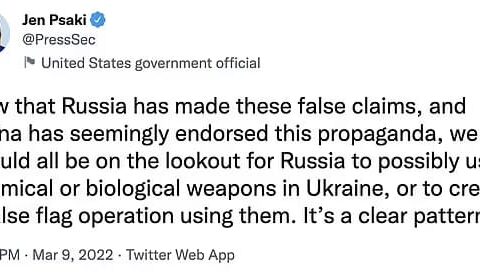Not for the first time in the course of the War in Syria, we are seeing major international reports of a chemical attack, allegedly having been carried out by the Assad government forces.
‘Assad regime drops chemical weapons on Syrian town in revenge for shot down Russian helicopter’, The Telegraph reports, stating it as pure fact and leaving little room for debate.
It continues, matter-of-factly, ‘The chemical weapon was dropped onto the town by the Assad regime late on Monday evening in an apparent act of revenge after nearby rebels shot down a Russian transport helicopter, killing five Russian troops. The regime helicopter swept over the town of 30,000 and dropped at least two canisters of liquid chlorine, a chemical with a thousand benign uses now turned into a weapon of war by Syria’s government against its own people…’
Al-Jazeera, which began propagandising against both the Syrian and Libyan states from the beginning of the Arab Spring in 2011, is unsurprisingly also firmly convinced it was the Syrian government that carried out the attack.
The BBC, to its credit, is more objective in its reporting, stating that ‘Barrels suspected to contain chlorine gas have been dropped on a town in Syria… It is not clear who was responsible.’
Social media accounts from within Syria can be regarded as being of unreliable authenticity, and it is important to note that initial reports originated with the very questionable Syrian ‘White Helmets’ organisation, who also put out a video claiming to show victims being treated (Vanessa Beeley has covered the White Helmets at length: see here).
Chemical attacks have been reportedly carried out in Syria a number of times during the course of this Civil War, with both the regime and the various rebel groups being accused of the attacks at different times.
Much of the international media’s reflex seems to be to immediately attribute such attacks to the Assad government – simply because this is the script that was established in the earliest incidents in 2013. For the record, a government source in Syria is reported to have stated this latest attack was carried out against Syrian Army personnel. In fact, in this current instance, there appear to have been two different attacks in two different locations: one in a rebel held area and one in a government-controlled area. Neither side is admitting responsibility.
While accusations of chemical attacks by the Syrian regime have persisted throughout the war, we should note that as recently as a few months ago, ‘ISIS’ was reported to have carried out chemical attacks on the Syrian Army. In fact on June 18th this year, a chemical attack occurred in Ghoutta – the same location as the infamous 2013 chemical attack – and was reported by differing sources as both an attack by the Syrian regime and as an attack by Western-backed rebels against Syrian Army targets.
It is worth bearing in mind the broader context in which this latest (alleged) chemical attack has occurred.
The attack on the town of Saraqib came as fighting continues to rage in Aleppo, where Syrian Army forces – aided by Russia and Iran – have cut off several opposition-held neighborhoods and rebel fighters have been engaged in a counter-offensive to prevent the government forces from retaking the city. The government’s reclamation of Aleppo – which has been in rebels’ hands for years now – would, along with the retaking of Raqqa from the so-called ‘Islamic State’, mark a major, major moment in the conflict and could, in effect, herald the end of the long, bloody, foreign-backed uprising.
We must note as well that alleged chemical attacks by the Assad government have been the key thing Western officials have previously used as a basis for military intervention in Syria.

In 2013, the Ghouta chemical attack was poised to be for Assad what the WMDs had been for Saddam Hussein and what Benghazi had been for Gaddafi – the justification for Western military intervention and forced regime change.
This latest ‘chemical attack’ comes at a moment where rebel/jihadist groups are on the brink of defeat and desperate to stall what appears to be an inevitable reclamation of Aleppo by the Russian/Iranian-backed Syrian Army. It would suit them very clearly to have international powers and media go back tothe 2013 script at this time and for the accusation of chemical warfare to again hang over the Assad regime.
It is questionable, however, what the motive would be for the Syrian regime to carry out chemical attacks at this time. It really wouldn’t need to resort to anything like that when it is poised to win in Aleppo without it. Also, the Assad regime would know that any attack of that character would be scrutinised by the international community, would cast doubt on the government’s fitness to be a part of the post-war ‘transition’ and would also reflect badly on Russia’s involvement on their side.
None of which makes it impossible that regime forces might’ve used such a deplorable method of attack (or that an Iranian-dominated offensive would be willing to resort to such methods against an entirely Sunni target-area). But the logic has to be to doubt it, particular when we do the simple math of consulting the past instances; the most controversial instances of which are recounted below.
_________________
On March 19th 2013 (yes, March 19th – the same date that saw the 2003 Iraq War begin and the same date that saw the 2011 NATO intervention in Libya begin), sarin gas was used near Aleppo.
Without waiting for any proof or investigation, Israel and the US immediately blamed the Syrian government for the attacks even though many of those killed were actually Syrian government soldiers. Hillary Clinton, President Obama, David Cameron and numerous others began talking about the event as a “red line” that had been crossed and the warmongers in both government and media began their by-now familiar propaganda march towards war.
From that point on, Assad’s government, like those of Muammar Gaddafi and Saddam Hussein before him, appeared to have its days numbered, with US/NATO-led military intervention imminent.
However the UN – in a rare display of independence, perhaps influenced by the disaster that had recently unfolded in Libya – insisted on investigating the issue for itself, and on May 6th 2013 the UN investigator Carla Del Ponte went public stating that evidence from their investigation indicated that it was Syrian rebels that had used the sarin gas and that there was no indication that the Syrian government had launched any chemical attacks whatsoever.
Del Ponte, who like everyone else had been previously misled by government officials in the West, was surprised by her own findings; “I was a little bit stupefied at first”. This was reported even by the BBC on May 6th 2013. It was stated definitively by investigators: ‘This was use on the part of the opposition, the rebels, not by the government authorities.’
Then there was the subsequent attack on August 21st 2013, when foreign governments and the corporate media attempted once again to frame the Syrian government for the use of sarin gas… and once again these claims were exposed as fraudulent. Concerning the chemical attack of August 2013 in the Eastern Ghouta region (just outside Damascus), one thing that was scarcely mentioned in mainstream coverage was that the Syrian Government had been complaining for months about terrorist gas-attacks and had even invited UN inspectors to Damascus to investigate (echoing, to some extent, Gaddafi practically begging UN investigators to come to Libya to see what was really going on – and which the UN didn’t bother to do).
When these inspectors arrived, ‘rebel’ groups posted videos of dead children to the Internet, blaming the Syrian Government for a new massacre. The US government – again without any attempt to verify the ‘evidence’ or investigate independently – was quick to agree. Due to US/Western pressure and interference, the UN investigation of the chemical attacks was cancelled and all attention moved onto the horrendous matter of the gassed children.

The western media went into overdrive, up in arms over this ‘outrage’ by the Assad regime, and renewed the demands for military intervention to force regime change in Syria.
A major escalation of the war at this point was only defused by Russian diplomatic intervention and a proposal that Syria hand over its chemical weapons stockpile; which the Syrian regime maintained had never been used.
Soon after, a journalist in Jordan reported that residents in East Ghouta were blaming the “Saudi Prince Bandar of providing chemical weapons to an Al- Qaeda linked rebel group”. Prince Bandar, as many know, is a major player in (and financer of) international terrorism, particularly Al-Qaeda and Salafist/Islamist groups.
A Syrian Christian group led by a Mother Agnes Mariam conducted a detailed examination of the video evidence and concluded that the massacre videos had used ‘staged’ and ‘fake’ images.
Meanwhile, the Pulitzer Prize winning journalist Seymour Hersh reported that “The American and British intelligence communities had been aware since the spring of 2013 that some rebel units in Syria were developing chemical weapons.” One source told Hersh, “Investigators interviewed the people who were there, including the doctors who treated the victims. It was clear that the rebels used the gas. It did not come out in public because no one wanted to know.”
In a lengthy article published by the London Review of Books, the investigative journalist reported that the sarin gas attack on a Damascus suburb on August 21st 2013 was carried out by Syrian “rebel” forces carrying out the wishes of Turkish intelligence – all for the purpose of providing a pretext for a US-led ‘intervention’ to carry out regime-change in Syria.

Hersh has also concluded that Hillary Clinton personally approved the sending of sarin from the chaos of the then freshly-fallen Libya and into the hands of Syrian rebels.
Chemical and biological weapons were most likely provided to the extremists in Syria by the US. There is also, however, a case to be made for Turkey having been the provider – or at least the middleman.
Just as with Gaddafi and Benghazi, Assad and the chemical attacks were the manufactured basis for international leaders and officials to demand that ‘Assad Has to Go’ – led of course by Hillary Clinton, who was simply repeating all her same mantras from the Libya intervention, but simply substituting ‘Gaddafi’ for ‘Assad’ in all of her statements.
That plan for intervention and regime change was stopped, partly by Russian diplomacy, partly by the brutal, dramatic rise of ‘ISIS’ (which served to suddenly show the broader international community what the internationally-backed armed ‘opposition’ in Syria actually looked like), and partly by the British parliament refusing to support Washington’s rush towards yet another war.
But time is running out for the ill-conceived covert war to destroy Syria as a nation: the jihadist and rebel groups know time is running out, and their foreign backers know this too. The only hope now to revive the regime-change war in Syria might be Hillary Clinton assuming the US presidency – but Bashar Assad and his allies know they’d be best served to finish this conflict before that happens; while the various rebel militias and their sponsors know that they have to buy more time.
Which means extreme actions are likely, as well as a desperate escalation of propaganda.





Reblogged this on sand49.
It’s such bollocks I hate. Rare time look at mainstream paper (physically) pile a lies.
We must post-up this more. Do something me, and we, say.